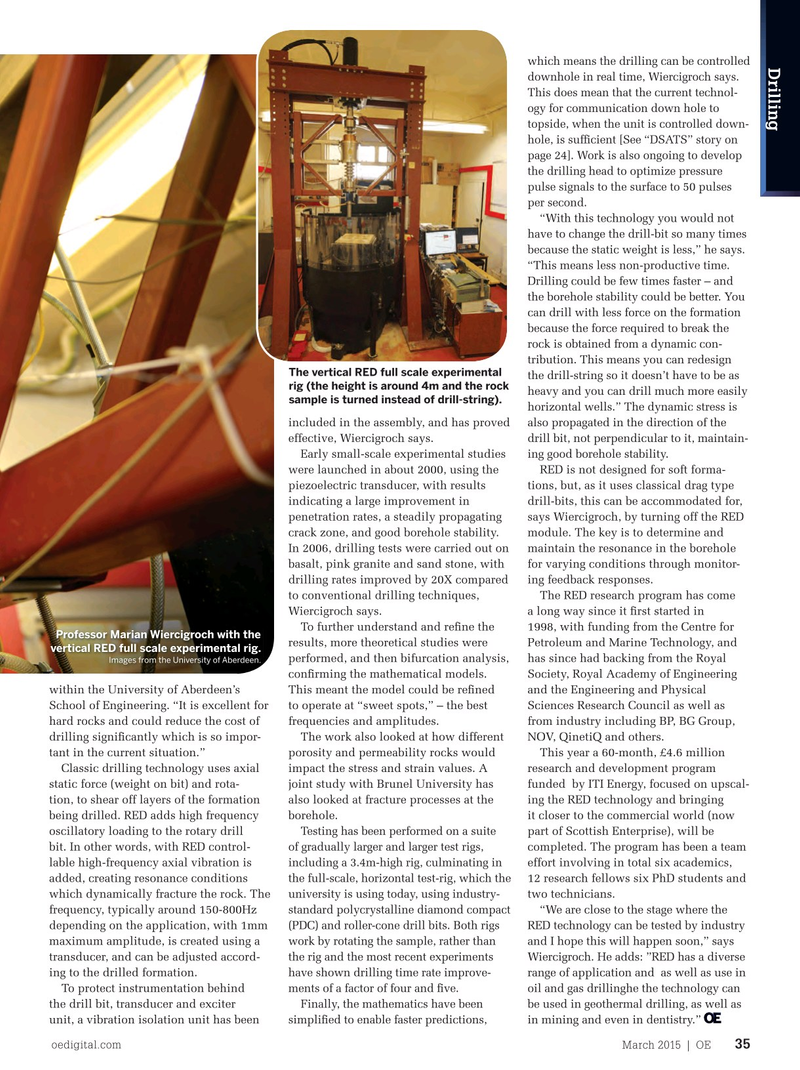
Page 33: of Offshore Engineer Magazine (Mar/Apr 2015)
Read this page in Pdf, Flash or Html5 edition of Mar/Apr 2015 Offshore Engineer Magazine
which means the drilling can be controlled
Drilling downhole in real time, Wiercigroch says.
This does mean that the current technol- ogy for communication down hole to topside, when the unit is controlled down- hole, is suf? cient [See “DSATS” story on page 24]. Work is also ongoing to develop the drilling head to optimize pressure pulse signals to the surface to 50 pulses per second.
“With this technology you would not have to change the drill-bit so many times because the static weight is less,” he says. “This means less non-productive time.
Drilling could be few times faster – and the borehole stability could be better. You can drill with less force on the formation because the force required to break the rock is obtained from a dynamic con- tribution. This means you can redesign
The vertical RED full scale experimental the drill-string so it doesn’t have to be as rig (the height is around 4m and the rock heavy and you can drill much more easily sample is turned instead of drill-string). horizontal wells.” The dynamic stress is included in the assembly, and has proved also propagated in the direction of the effective, Wiercigroch says. drill bit, not perpendicular to it, maintain-
Early small-scale experimental studies ing good borehole stability. were launched in about 2000, using the RED is not designed for soft forma- piezoelectric transducer, with results tions, but, as it uses classical drag type indicating a large improvement in drill-bits, this can be accommodated for, penetration rates, a steadily propagating says Wiercigroch, by turning off the RED crack zone, and good borehole stability. module. The key is to determine and
In 2006, drilling tests were carried out on maintain the resonance in the borehole basalt, pink granite and sand stone, with for varying conditions through monitor- drilling rates improved by 20X compared ing feedback responses. to conventional drilling techniques, The RED research program has come
Wiercigroch says. a long way since it ? rst started in
To further understand and re? ne the 1998, with funding from the Centre for
Professor Marian Wiercigroch with the results, more theoretical studies were Petroleum and Marine Technology, and vertical RED full scale experimental rig. performed, and then bifurcation analysis, has since had backing from the Royal
Images from the University of Aberdeen.
con? rming the mathematical models. Society, Royal Academy of Engineering test rigs (see the photograph and sche- within the University of Aberdeen’s This meant the model could be re? ned and the Engineering and Physical matic of the vertical and horizontal RED School of Engineering. “It is excellent for to operate at “sweet spots,” – the best Sciences Research Council as well as experimental rigs). hard rocks and could reduce the cost of frequencies and amplitudes. from industry including BP, BG Group,
The result, he says, is a ? exible tech- drilling signi? cantly which is so impor- The work also looked at how different NOV, QinetiQ and others. nique, able to be optimized according to tant in the current situation.” porosity and permeability rocks would This year a 60-month, £4.6 million rock type, which could improve on aver- Classic drilling technology uses axial impact the stress and strain values. A research and development program age drilling rates by at least 40%. In case static force (weight on bit) and rota- joint study with Brunel University has funded by ITI Energy, focused on upscal- of hard rock drilling, the improvement tion, to shear off layers of the formation also looked at fracture processes at the ing the RED technology and bringing can be as large as 250%. being drilled. RED adds high frequency borehole. it closer to the commercial world (now
Testing has been performed on a suite “There is nothing similar out there,” oscillatory loading to the rotary drill part of Scottish Enterprise), will be of gradually larger and larger test rigs, says Wiercigroch, who is director of the bit. In other words, with RED control- completed. The program has been a team including a 3.4m-high rig, culminating in
Centre for Applied Dynamics Research lable high-frequency axial vibration is effort involving in total six academics, the full-scale, horizontal test-rig, which the added, creating resonance conditions 12 research fellows six PhD students and university is using today, using industry- which dynamically fracture the rock. The two technicians. standard polycrystalline diamond compact frequency, typically around 150-800Hz “We are close to the stage where the (PDC) and roller-cone drill bits. Both rigs depending on the application, with 1mm RED technology can be tested by industry work by rotating the sample, rather than maximum amplitude, is created using a and I hope this will happen soon,” says the rig and the most recent experiments transducer, and can be adjusted accord- Wiercigroch. He adds: ”RED has a diverse have shown drilling time rate improve- ing to the drilled formation. range of application and as well as use in ments of a factor of four and ? ve.
To protect instrumentation behind oil and gas drillinghe the technology can
Finally, the mathematics have been the drill bit, transducer and exciter be used in geothermal drilling, as well as simpli? ed to enable faster predictions, unit, a vibration isolation unit has been in mining and even in dentistry.” oedigital.com March 2015 | OE 35 034_OE0315_D&C_RED.indd 35 2/22/15 11:23 AM

 32
32

 34
34